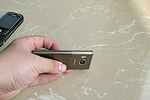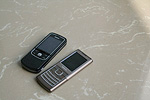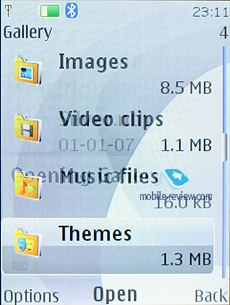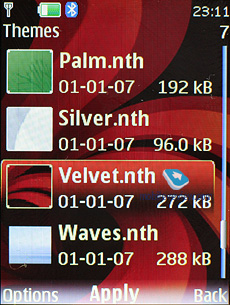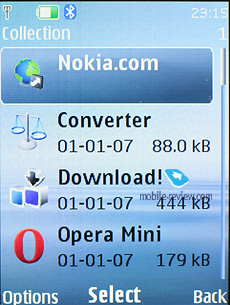|
|
Review GSM/UMTS-handset Nokia 6500 classic
Live photos of Nokia 6500 classic
Table of contents:
- Preface
- Design, materials
- Keypad
- Display
- Memory
- Battery
- USB, Bluetooth
- Performance
- Camera
- Themes, applications
- Nokia 6500 Classic versus Nokia 6300
- Competition
- Impressions
Sales package:
- Handset
- Wired stereo-headset (HS-82)
- Charger (AC-6)
- Li-Pol battery (BL-6P)
- Micro USB data cable (CA-101)
- User Guide
- Software CD
Preface
The story of this model is very remarkable and has much to do with how the company’s vision of its product line-ups development changed over time and what expectations the company had for its future phones. By summer 2005, over at Nokia they had grown unhappy with the way their product design had been going, and this resulted in Frank Nuovo resignation. This event was followed by, if not dramatic, but still a substantial revision of the product creation approach, which allowed the line of “slim” devices to emerge - the development of these solutions commenced in the middle of 2005. Back then, the company, already lagging behind both Samsung and Motorola, the trailblazer in slim phones, began looking into the ways of rolling out similar offerings.
They started off with a bunch of models, one of them was codenamed Lynn (today known as the Nokia 6500 Classic). Christian Riise managed the product, whose development kicked off in August 2005. First results and a rough spec sheet had shaped up even before September 2005 ended, after this point they engaged themselves in the development of the hardware department, as well as design.

The image of the device was finalized by December, and its first designs employed plastic. In February 2006 this device was tested out on a focus group in Moscow and several other cities. Apart from this model, they also showcased designs of the Nokia 6300 and a couple of other handsets. Curiously, when the users put Nokia 6300 and Nokia 6500 Classic head to head, it was the latter that came out victorious, as it seems a tad classier.
The Nokia 6500 Classic was originally issued in silver, but some focus-group members noticed that this color doesn’t belong on handset. That’s why in March they rolled out a black-colored model and only then the one in bronze.

The hardware department of Nokia 6500 Classic has become the foundation for a whole array of Nokia-branded solutions – that is, the market has already seen the Nokia 5310.
Back to the table of contents >>>
Design, materials
The Nokia 6300 is positioned as a designer solution, but at the same time it belongs to the Connect – Contemporary category in Nokia’s books, like the Nokia 6500 classic. While the former device has been pushed under the motto «Simply Beautiful», the latter has had a couple of aspects highlighted, with materials, rather than design, being the centerpiece of the ad campaign. The maker doesn’t trick us, claming that the device is made of metal – indeed, the top part is made of anodized aluminum. And, no matter how you look at it, on the top, metal is everywhere. At the same time they claim every device has unique front polishing to it, there are no two models that look alike. I readily believe in this as well, but in real life conditions, you can barely spot the difference in metal polishing, all 6500 Classic look resembling.


The entire underside is a kind of a “shoe” dressing up the handset’s innards. This solution has already been used for rugged Nokia’s phones, for example, the Nokia 5100 and its successors. This part of the casing enjoys only moderately thick plastic. The antennas are also located here, even though such lay-out doesn’t seem normal, it is successfully utilized in many other phones, for example, from Motorola.

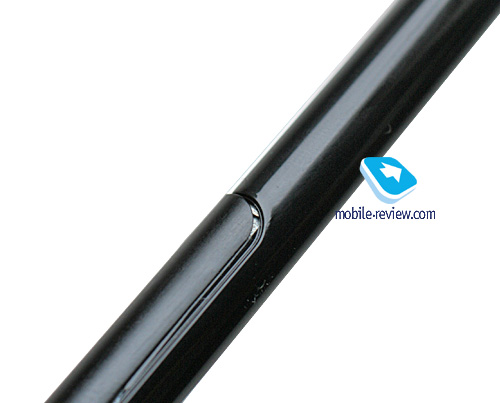


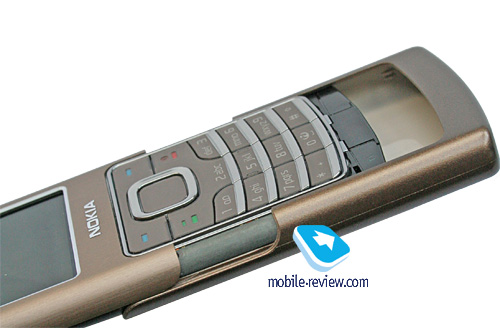
If we draw parallels between this one and the Nokia 6300, there is no stainless steel here, and moreover the casing itself doesn’t seem like something ultra-hard or packed with metal. The Sony Ericsson W880i feels the same way to a certain extent – you don’t get the solid feel with all that metal it houses, and it is very inconspicuous.




The handset measures 109.8x45x9.5, weights 94 grams. Both parameters are more than satisfactory for carrying the handset even in slim-fit jeans. One of our readers recently complained that it was next to impossible to have the Nokia 8800 in shirt’s pocket – it kept weighing it down. I really can’t comment on this – my shirts don’t let themselves do such things, probably, that’s because of their bigger size.


The model comes in two color schemes – black and bronze. Either looks fetching, on top of that very model ships with a color-keyed theme, which adds certain chic to it.


Back to the table of contents >>>
Keypad
The handset’s buttons are made of plastic and lit in white, which is well-visible in various environments. The keys are average in size and employ terraced layout, but more importantly, the 6500 Classic does well on the ergonomics front, the buttons are easy to tap and very responsive.




Back to the table of contents >>>
Display
The Nokia 6500 Classic utilizes a QVGA display, powered by the TFT technology (16 mln colors, which are all bright and vibrant) with the resolution of 240x320 pixels (2-inch diagonal, 31x41 mm). The manufacturer hasn’t included any type of backlighting adjustment, i.e. the screen is always evenly backlit, which allows saving a bit of battery charge. Nevertheless the user is enabled to choose standby screensaver and backlighting mode (on/off) – in the latter case the information will remain visible while indoors but only at certain angles. Apart from that you can turn off the screen, so that it will turn black with no information being displayed on it. In light of the display having a mirror layer, it doesn’t fade in the sun and ensures that all data will remain readable.

Back to the table of contents >>>
Memory
The handset comes with no memory card slot – the manufacturer has deemed the 1Gb storage found in the 6500 Classic by default enough for most consumers. While it can’t match the most popular high-capacity cards (around 2 Gb), but it is a decent solution for the average user.

Back to the table of contents >>>
Battery
The handset ships with a 830 mAh Li-Pol battery (BL-6P). As the manufacturer puts it, this cell can keep the phone up and running for 215 hours in standby or provide 9 hours of talk time. In Moscow the battery time averaged 2 days at 2 hours of calls and up to 5 hours of music. It takes the battery about 2 hours to charge up from empty to full.

In terms of battery life, this handset is pretty much in line with the Nokia 6300.
Back to the table of contents >>>
USB, Bluetooth
USB. The Nokia 6500 classic makes use of the microUSB slot placed on the top end. This socket kicks in when you connect data cable, headset or charger. As long as the data cable is connected, the battery will be recharging automatically.


The vendor says that the handset supports USB 2.0, and it does indeed, in the USB Mass Storage mode the USB cable connection offers medium data transfer speed which tops out at 500-600 Kb/s. This is slower than the Motorola RAZR2 V8, which also comes installed with the microUSB-socket.
Upon a successful connection you can pick USB Mass Storage, PC Studio or the modem mode. Depending on your choice, the handset starts recharging the cell. It has no support for MTP, though, so you will have to upload all your tunes manually. The selection of folders, where music gets identified is limited to a couple of pre-installed directories.
Bluetooth. The 6500 Classic comes equipped with EDR-enabled version 2.0. The device supports the following profiles:
- Dial-Up Networking Profile
- Generic Access Profile
- Generic Object Exchange Profile
- Object Push Profile
- Serial Port Profile
- Handsfree Profile
- Headset Profile
- Synchronization Profile
- Basic Image Profile
- File Transfer Profile
- HID (host) Profile
- Stereo Advanced Audio Distribution Profile
- Advanced Audio/Video Remote Conference Profile
The Bluetooth implementation is, as always though, nothing to complain about, we encountered no issues with handling this type of connections. The stereo-headset also works fine with the 6500 Classic.
Back to the table of contents >>>
Performance
The phone is a typical offering for its generation – no revelations here.

Back to the table of contents >>>
Camera
The model has received a camera model absolutely identical to that of the Nokia 6300 with no substantial changes. That’s why we are taking the camera review and sample shots from the respective write-up. This handset has a 2mpx camera (CMOS) which is not that much by today’s standards, but it is still pretty enough for a mid-range model. Nokia has decided not to bank on the camera department, so as far as the 6500 Classic is concerned, it is more of an optional feature. That’s why the camera module that was selected for 6500 Classic is one of the cheapest out there, and provides average quality, if not to say meager. In poor light conditions, this camera won’t snap good photos, that’s for sure – its exposure time increases and every movement of your hand leads to a blurry image in the end.

The following resolutions are supported:
- 1600x1200;
- 1280x960;
- 800x600;
- 640x480;
- 320x240;
- 160x120.
Two lower resolutions were added for creating photos that would fit as wallpapers for display. Three JPEG compression types are supported: basic, normal, high. Considering the fact that photos do not blow your imagination away, it is better to go for the top quality, it won’t get any worse after all.
The shutter sound can be disabled, also there is a 8x digital zoom, but there is no reason to use it. You can save photos in the internal memory or on the memory card.
Some effects can be applied to the already made photos, should they be used initially – it is up to you to decide. Such effects as False Colours, Greyscale, Sepia, Negative, Solarize are available.
 |
 |
| (+) maximize, 1200x1600, JPEG |
(+) maximize, 1200x1600, JPEG |
 |
 |
| (+) maximize, 1200x1600, JPEG |
(+) maximize, 1200x1600, JPEG |
 |
 |
| (+) maximize, 1200x1600, JPEG |
(+) maximize, 1200x1600, JPEG |
 |
 |
| (+) maximize, 1200x1600, JPEG |
(+) maximize, 1200x1600, JPEG |
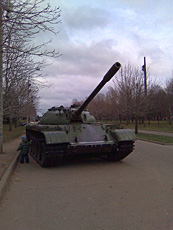 |
 |
| (+) maximize, 1200x1600, JPEG |
(+) maximize, 1200x1600, JPEG |
 |
 |
| (+) maximize, 1200x1600, JPEG |
(+) maximize, 1200x1600, JPEG |
 |
 |
| (+) maximize, 1200x1600, JPEG |
(+) maximize, 1200x1600, JPEG |
 |
 |
| (+) maximize, 1200x1600, JPEG |
(+) maximize, 1200x1600, JPEG |
 |
 |
| (+) maximize, 1200x1600, JPEG |
(+) maximize, 1200x1600, JPEG |
 |
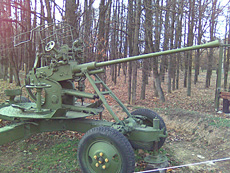 |
| (+) maximize, 1600x1200, JPEG |
(+) maximize, 1600x1200, JPEG |
 |
 |
| (+) maximize, 1600x1200, JPEG |
(+) maximize, 1600x1200, JPEG |
 |
 |
| (+) maximize, 1600x1200, JPEG |
(+) maximize, 1600x1200, JPEG |
 |
 |
| (+) maximize, 1600x1200, JPEG |
(+) maximize, 1600x1200, JPEG |
 |
 |
| (+) maximize, 1600x1200, JPEG |
(+) maximize, 1600x1200, JPEG |
For those who love to shoot a lot of photos at once, there is special mode for you – camera makes up to 3 shots at a time, all settings remain similar to those selected for the single shot mode, including the resolution. There is an auto-timer for self-shots.
Video. The handset allows recording video in 3GP format, available resolution – 128x96 pixels, or 176x144 pixels. There are three recording quality settings available. You can limit a recording’s length, but it also can be unlimited, so you will keep recording until the memory runs out (memory card or internal memory). Effects can be applied for video just as they can be applied for photos, they are all the same.
Video sample 1 (3gp, 336 Kb)>>>
Video sample 2 (3gp, 224 Kb)>>>
Video sample 3 (3gp, 300 Kb)>>>
Back to the table of contents >>>
Themes, applications
The handset comes pre-installed with a number of themes that do make the difference in terms of how the menu looks; all themes are well-designed and match the phone’s image.
The standard suite of applications includes Unit Converter, Nokia Sensor. Select markets might also get some other games and applications. Java can be uploaded over the air or directly into the memory bank, no caps on file size.
Back to the table of contents >>>
Nokia 6500 Classic versus Nokia 6300
Two members of Nokia’s “slim” range, both have own pros and cons. Let’s take a closer look at either phone’s traits, hopefully, somebody might find this useful.
| |
Nokia 6500 classic |
Nokia 6300 |
| Size, weight (mm, g) |
109.8x45x9.5, 94 |
106.4x43.6x11.7, 91 |
| Display |
QVGA, 2 inches, 16 mln colors, TFT |
QVGA, 2 inches, 16 mln colors, TFT |
| Battery |
Li-Pol, 830 mAh |
BL-4C, 760 mAh |
| Memory |
1 Gb built-in |
9 Mb built-in, microSD uo to 2 Gb |
| OS version |
S40 5th Edition |
S40 3rd Edition FP2 |
| UMTS |
Yes |
No |
| Camera |
2-Mpix CMOS. Video recording at 176x144 pixels |
2-Mpix CMOS. Video recording at 176x144 pixels |
| Sockets |
microUSB for all connection types |
miniUSB, 2.5 mm, charger socket |
| Bluetooth |
2.0 + EDR, A2DP support |
2.0 + EDR |
| Player |
Enhanced |
Standard |
| Materials |
Anodized aluminum, plastic |
Stainless steel, plastic |
| Price |
320 Euro |
250 Euro when released |
Obviously, the Nokia 6500 Classic has improved over the predecessor functionality-wise. On balance, the only drawbacks to it are fixed memory volume and slightly shorter standby battery life. Its higher price is the result of the enhanced features and different price segments chosen for these models.








Back to the table of contents >>>
Competition
The market hasn’t seen to many devices housed in the candy-bar form-factor that sport wafer-thin profile. Technically, the Samsung U100 is one of these, but this is the slimmest solution around with no big storage or memory expansion slot onboard, that’s why it is pretty much pointless to include it into this face-off. The Sony Ericsson W880i seems to be a direct competitor; however it does have a somewhat different positioning. On top of that, the Motorola SLVR L9 also qualifies as an indirect rival.
| |
Nokia 6500 classic |
Sony Ericsson W880i |
Motorola SLVR L9 |
| Size, weight (mm, g) |
109.8x45x9.5, 94 |
103x47õ9.4, 73 |
113.5x49x11.5, 98 |
| Display |
QVGA, 2 inches, 16 mln colors, TFT |
QVGA, 1.8 inches, TFT, 262000 colors |
176x220, TFT, 262000 colors |
| Battery |
Li-Pol, 830 mAh |
Li-Pol, 950 mAh |
Li-Ion, 880 mAh |
| Memory |
1 Gb built-in |
40 Mb, MS M2 memory card (comes with 1Gb) |
20 Mb built-in, microSD card |
| OS version |
S40 5th Edition |
SE A100 |
P2K |
| UMTS |
Yes |
Yes |
No |
| Camera |
2-Mpix CMOS. Video recording at 176x144 pixels |
2-Mpix CMOS. Video recording at 176x144 pixels |
2-Mpix CMOS. Video recording at 176x144 pixels |
| Sockets |
microUSB for all connection types |
Fast Port, 3.5 mm on headset |
miniUSB |
| Bluetooth |
2.0 + EDR, A2DP support |
2.0 + EDR, A2DP support |
2.0 + EDR, A2DP support |
| Player |
Enhanced |
Walkman 2.0 |
Java-player, default solution |
| Materials |
Anodized aluminum, plastic |
Plastic, metal plates |
Anodized aluminum, plastic |
| FM-Radio |
No |
No |
Yes |
| Price |
320 Euro |
400 Euro |
300 Euro |
If we compare the Nokia 6500 classic with the Motorola L9, the Nokia’s offspring comes out on top in terms of size, screen quality, default memory size and player implementation. The only saving grace for Motorola’s offering is the fact that its price tag of 300 Euro won’t last longer than a short period of time after the release day.



The Nokia’s model shares much in common with the Sony Ericsson W880i – really resembling retail packages, in both cases the user gets 1 Gb of storage right out of the box. Functionality-wise, the players in these two are top-notch, but the Sony Ericsson’s solution outputs a tad better sound (thanks to its superior bundled headset). However this product feels somewhat overpriced, as these two handsets should have equally hefty price tags, although by the time the 6500 Classic comes out, the Sony Ericsson W880i will have long since been rolled out. If you face the dilemma of choosing between them, you would be better off going with your personal feelings; either of the solutions is pretty decent. Speaking of the 6500 Classic’s edge, I can’t overlook its conventional keypad whose ergonomics trump that of the Sony Ericsson W880i.
Back to the table of contents >>>
Impressions
The volume of 72-tone polyphony is enough for almost all environments. The 6500 Classic also does fine on the reception front, as it stands up to all other phones of the current generation. The vibro alert is average strength-wise, but can be still felt while the handset is in pocket.
This is the key offering for Nokia, so the maker’s substantial marketing activities come as no surprise. In the vast majority of European regions, it retails for around 320-350 Euro, whereas in Russia it sells for 650 USD or more. The phone has been positioned as a fashion-savvy solution in the first place – its target audience is not really into mobile powerhouses.
Over the month of our quality time with a commercial unit, we couldn’t a reason to fault its coating or performance. However, our handset had some problems with the “shoe” which didn’t fit the upper part of the casing very well – in fact, there is no one else to blame for this but us, and we couldn’t fix this, regrettably. Short of that problem, we didn’t notice any other flaws with the 6500 Classic.
The 6500 Classic is an pleasant phone to use. It doesn’t really qualify as a music-minded solution, even though it does okay on the music front. The list of its direct competitors has only the Sony Ericsson W880i, but the latter has been around for a while now, whereas the Nokia 6500 Classic has the momentum behind it.
The SAR level for the 6500 Classic – 0.87 W/kg
Related links:
Back to the table of contents >>>
Eldar Murtazin ([email protected])
Translated by Oleg Kononosov ([email protected])
Published — 06 December 2007
Have something to add?! Write us... [email protected]
|
News:
[ 31-07 16:21 ]Sir Jony Ive: Apple Isn't In It For The Money
[ 31-07 13:34 ]Video: Nokia Designer Interviews
[ 31-07 13:10 ]RIM To Layoff 3,000 More Employees
[ 30-07 20:59 ]Video: iPhone 5 Housing Shown Off
[ 30-07 19:12 ]Android Fortunes Decline In U.S.
[ 25-07 16:18 ]Why Apple Is Suing Samsung?
[ 25-07 15:53 ]A Few Choice Quotes About Apple ... By Samsung
[ 23-07 20:25 ]Russian iOS Hacker Calls It A Day
[ 23-07 17:40 ]Video: It's Still Not Out, But Galaxy Note 10.1 Gets An Ad
[ 19-07 19:10 ]Another Loss For Nokia: $1 Billion Down In Q2
[ 19-07 17:22 ]British Judge Orders Apple To Run Ads Saying Samsung Did Not Copy Them
[ 19-07 16:57 ]iPhone 5 To Feature Nano-SIM Cards
[ 18-07 14:20 ]What The iPad Could Have Looked Like ...
[ 18-07 13:25 ]App Store Hack Is Still Going Strong Despite Apple's Best Efforts
[ 13-07 12:34 ]Infographic: The (Hypothetical) Sale Of RIM
[ 13-07 11:10 ]Video: iPhone Hacker Makes In-App Purchases Free
[ 12-07 19:50 ]iPhone 5 Images Leak Again
[ 12-07 17:51 ]Android Takes 50%+ Of U.S. And Europe
[ 11-07 16:02 ]Apple Involved In 60% Of Patent Suits
[ 11-07 13:14 ]Video: Kindle Fire Gets A Jelly Bean
Subscribe
|



